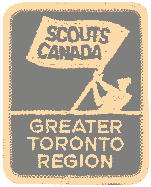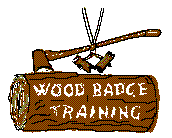
www.gtrsi.com
 |
www.gtrsi.com |
 |
 The Wood Badge
The Wood BadgeTwo tiny wooden beads on a leather thong doesn't sound like an outstanding badge and mark of distinction, but it is known and res- pected as such around the world. It is symbolic of the efforts and interests of one man, on behalf of others, that created and launched the greatest movement for youth the world has ever known.
It is the mark of those who have demonstrated that they are people of character and who are devoted to a cause; adults who strive for perfection, well knowing that even the best is not enough; adults who hold the welfare of others before self; Scouters who live up to all that the name implies. The Wood Badge is awarded to Scouters on the basis of what they think, more than on what they know. They must demonstrate that they "know how", also. Good intentions count for little until, by the application of ability and determination, they produce results that count. Striving for perfection in themselves that they might better train and coach others to this end, exists the wood badge.
It is doubtful that the thought ever entered the mind of Robert Baden- Powell, that his efforts on Brownsea Island would grow to influence the youth of the world and that in the days ahead, thousands upon thousands of men and women would carry his efforts forward to an ever increasing number of young people and adults.
Who knows, but to this effort, this crusade may flourish to the end that
two tiny wooden beads on a leather thong may yet become the symbol
of a succeeding effort to bring about a world brotherhood of people
under the watchful eye of God. To that end, may the wood badge
serve and the Scouters never falter or fail. Two tiny wooden beads on
a leather thong; they could symbolize the hope of the world. It's up
to you.
Author Unknown
The Badge itself is the thong, but holders of it also have the Gilwell Scarf, the Gilwell Woggle and the Parchment.
During the uprisings in South Africa about the time of the Boer War, while Baden-Powell was serving with the Imperial Army, he suppressed one of the tribes, known as the Zulus, headed by King Dinizulu. B-P became friends with Dinizulu and later was given the beads worn by the King denoting his chieftainship. These consisted of hundreds of "wooden beads" resembling bones. B-P kept these for years and at the first training course held for leaders at Brownsea he felt that because of the great amount of effort put forth the leaders should have some distinctive badge. He remembered Dinzulu's beads, broke them up and gave two beads on the end of a leather thong to each leader taking part in that course. Later, when the supply of beads ran short, one original bead and one facsimile (made in Gilwell Park) were given to those leaders successfully completing the course. Now leaders receive two facsimiles. These beads are not made at Gilwell Park now. The Wood Badge training course, as it is called, is the highest form of training available for the leaders.
Kenneth duBois MacLaren was present at B-P's first Scout camp held at Brownsea Island in 1908 and remained a friend of B-P for life.
Towards the end of 1918, Mr. MacLaren, who was D.C. for Roseneath in Dumbartonshire, Scotland, offered to buy a camping ground which would be available for Scouts, especially those from the east of London. (MacLaren was not one of the Breownsea Scouts; he was an assistant). A small committee was formed and at the special request of B-P decided to look for an estate which would offer a camping ground and also act as a trining ground for Scouters.
Early is 1919, the committee heard of the estate of Gilwell Park being for sale and after the committee and Chief Scout inspected the grounds, Mr, MacLaren was told that the estate would suit. Negotiations were started at once. By Easter, permission was granted to use it for camping.
The Estate had been more or less derelict and much had to be done towards putting Gilwell Park in shape. The house consisted mainly of only four walls and consideration has been given to tearing it down. Mr. MacLaren came to the rescue and added a considerable sum to the purchase price in order that the house could be put in order.
In May 1919, Frances Gidney was appointed Camp Chief, the intention being that the camp should be kept open all year round. The first terms of reference were:
1. to be used as a training centre where Scouters would be trained by competent Scouters in the formation and training of troops, practical woodcraft and camping and the methods of Scouting generally.
2. to provide camping sites for troops and patrols, provide facilities for the practice of Scout craft and to give expert advice. This was intended especially for troops who were less experienced and troops of poorer Scouts who would otherwise be unable to study campcraft and woodlore.
The formal opening ceremony: The Chief Scout and Lady B-P were present to receive guests at tea. The house was formally opened by Mrs. MacLaren cutting a ribbon of Scout colours strung across the entrance. There was a rally of some 700 Scouts. There were congratulations by the Chief Scout on their acquisition, he thanked Mr. MacLaren and presented him with the Silver Wolf. The first Scoutmaster's training course was held from September 8 to 19, 1919, and was attended by 20 SM's from all parts of England and Wales.
The scarf is made of material known as the Gilwell Grey. The red on the inner side is said to be effective in absorbing the rays of the sun. The material was and is used in making shirts and jackets for hotter climates. At first, India was the only place where the material was made. This was sent to England where the scarves were made up. The scarves are still made in England. The tartan on the back is the MacLaren tartan, in memory and in honour of Kenneth duBois MacLaren.
This scarf may be worn by Scouters who have qualified for the Wood Badge. It denotes membership in the First Gilwell Troop and may be worn by the Scouter when he is not with or representing his Troop.
The woggle is a leather Turk's head. This can be worn by a leader completing Part I Wood Badge Training.
A certificate, signed personally - and not with a rubber stamp - by the Chief Scout for Canada, the Governor-General.
In 1911, B-P was made a knight, with the title "Sir". This is not a hereditary one and the title dies with the knight.
In 1920, he was created a Baronet, still with the title "Sir". This title is hereditary and is used by the first son of the Baronet.
In 1929, he was created a Baron, with the hereditary title of "Lord So-and-So of Somewhere. B-P chose the title "Lord Baden-Powell of Gilwell".
|
Disclaimer: Anything posted to this Home Page
are the opinions of the individuals who posted them and are not the views of Scouts Canada. |